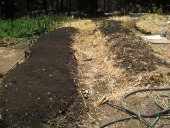posted 11 years ago
Actually I've been thinking about this a lot lately. Maybe too much.
I'm wondering if on my soil it's best to add biomass in small increments. Like 2-4 inches at a time. At least in the first year. It seems that in the first year or so, the soil life just isn't developed enough to really deal with large doses of biomass, and so it just sits doing not much.
In the second year, it seems you can really start piling it on, because then the micro-herds are better developed and the pores are well-developed enough that water does actually drain. In the first year, at least on the last property I did this, zero infiltration with large amounts of biomass.
Another option could be to do patches of low-biological life biomass (grass, leaves) and patches of higher-life biological life (leaves+grass+compost+manure) that already has a higher potential for life going in, which may speed up the process in some places.
The idea of radishes isn't really applicable to my spot, because it is deep, well into the sub soil, and I doubt anything could gain a foothold root-wise. I've worked with daikons and they have mixed results even in the top 4 inches of the soil. Plus the area is going to be covered with a foot or more of biomass when this is all done, so not much going on plant-wise in this spot.
William





![Filename: swale.jpg
Description: [Thumbnail for swale.jpg]](/t/34388/a/15786/swale.jpg)


















































